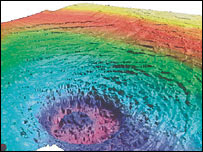The great North Sea impact crater vs. salt withdrawal basin debate
 That title doesn't quite roll off the tongue...oh well.
That title doesn't quite roll off the tongue...oh well.
A debate is currently going on (or at least now making it into the news) regarding the origin of a conspicuous feature found in the subsurface of the North Sea.
Here is the original BBC article.
Geologists from the oil exploration company BP discovered a circular structure about 3 km wide and 1 km deep in the subsurface about 130 km off the coast of England. Some are claiming it to be an impact crater while others have some other thoughts.
Two studies by Dr Stewart and Mr Allen (of BP), the latest of which mapped the structure in 3D, concluded that it was the result of a space impact.But, University of Edinburgh geology professor, John Underhill, has examined some of the data and disagrees.
"I decided to throw a more regional view at it, and ended up finding a whole load of these features with very similar cross sections," he said.It turns out that Underhill's approach has either uncovered a field of impact cr
 aters...or perhaps there's an alternative explanation.
aters...or perhaps there's an alternative explanation.[Underhill] says that the swarm of structures is the result of movement of a thick layer of salt of Upper Permian (248-256 million years ago) age that lies below the whole area.Granted, I've never worked the North Sea...I have worked on projects in the subsurface of the Gulf of Mexico, which is also influenced by the flow of salt, and it can produce a fantastic and wild subscape full of nearly circular minibasins. It seems that this explanation is a pretty good one, especially with this little tidbit:
"The key observation is that every single syncline is exactly coincident with where the salt has thinned or withdrawn," [Underhill] said.But, the ones who discovered the original feature in question still disagree.
Dr Stewart is un-moved. He points to a 300m-high central peak, or nipple, in the centre of the inner bowl, typical of impact craters.Alas...the debate is interesting enough to draw other researchers into it. The only real way to settle this is to drill, sample, and look for evidence of impact in the rocks (e.g., shocked quartz).
Hmmm....what are the chances BP will pay for that?

No comments:
Post a Comment